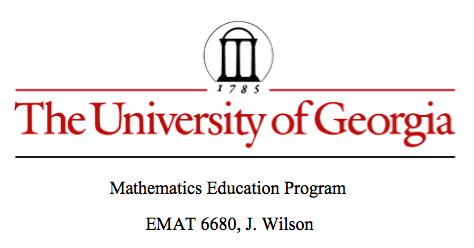

Assignment 9
Pedal Triangles
by
Megan Dickerson
In order to first explore the pedal triangle I created my pedal triangle carefully making sure that I constructed the perpendicular lines in a way that makes my pedal triangle exist no matter where I move P.
HERE is a link to my original pedal triangle in GSP.
Then, I decided that I wanted to look at multiple locations that the pedal triangle can be and what happens to it when it is located at the centroid, orthocenter, circumcenter, on the side of the triangle, and at one of the vertices of the triangle.
centroid
When P is located at the centroid, the pedal triangle is almost always inside the original triangle.
Click HERE to see the GSP link for when P is the centroid.

The only time that I could find that the pedal triangle is outside the original triangle when P is the centroid is when the original is an obtuse triangle. Even then, only part of the pedal triangle is outside.

It follows that since the centroid is always inside the original triangle that the Pedal triangle would also be inside the triangle since P would therefore be inside the original triangle. However, when the angle is obtuse, the perpendicular line from P to the side AB is outside the Triangle ABC. so part of the pedal triangle would have to be outside ABC.
Orthocenter
There are 2 cases for when P is located at the orthocenter. The orthocenter can be located inside and outside the original triangle.
When the orthocenter is inside the Triangle, so is the Pedal triangle.

As soon as the orthocenter leaves the original triangle, so does the pedal triangle. It doesn't fully leave, but is nonetheless, no longer contained in the original triangle.

Since the orthocenter is created by the lines perpendicular to each side of the original triangle from a point (the vertices), and the Pedal triangle is created by the lines perpendicular to the sides of the original triangle from a point (P), they have similar properties.
Click HERE to see the GSP file for when P is the orthocenter.
Circumcenter
When P is the circumcenter, the pedal triangle is the the same as the triangle formed by connecting the medians of the original triangle.


Even when the circumcenter is outside the triangle, the pedal triangle is made by connecting the medians. Since the triangle formed by connecting the medians is equal to 1/4 the area of the original (proof by similar triangle and parallel lines), the pedal triangle is also equal to 1/4 the area of the original triangle when P is located at the circumcenter.
Since the circumcenter is constructed from the perpendicular bisectors (perpendiculars of each side at the midpoints) and the pedal triangle is constructed from the perpendiculars to each side from P, when P = circumcenter, the perpendiculars from P to each side is located at the midpoints.
Click HERE to see my GSP file for when P is the circumcenter.
Side of Triangle
These images show what occurs when P is located on one of the sides of the original triangle.



In all three of these images, it can be observed that no matter what side P is on, and no matter where on that side P is located, P is the point where the perpendicular from P to that side is also located.
Vertex
I will look at three cases for when P is located on one of the vertices of the original triangle.
case 1 = The triangle is acute

The Pedal triangle becomes a line located inside the original triangle.
case 2 = The triangle is obtuse

The Pedal triangle becomes a line located outside the original triangle.
case 3 = The triangle is a right triangle.

The Pedal triangle becomes one of the sides of the original triangle.